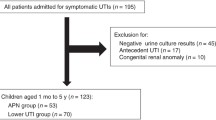Abstract
During acute inflammatory processes, extracellular release of granulocyte elastase can contribute to subsequent tissue damage. To test our hypothesis that extracellular elastase release during acute pyelonephritis may contribute to subsequent renal parenchymal damage, we compared the intracellular and extracellular activities of the lysozyme elastase of human polymorphonuclear cells (PMN) when incubated in vitro with bacterial strains causing renal infection that led to either renal damage or no damage. Urine bacterial cultures were obtained from patients with acute pyelonephritis (flank pain, costovertebral angle tenderness, fever >38°C, bacteriuria, pyuria, and leukocytosis). Renal damage was demonstrated by cortical scarring on followup intravenous pyelography and/or diminished function on131iodine hippuran renal scan. Mean extracellular elastase activity (μunits/PMN) was 0.15 for unstimulated PMN, 0.07 for PMN stimulated by bacteria not associated with renal damage, and 1.20 for the PMN stimulated by strains associated with renal damage. Mean intracellular elastase activity (μunits/PMN) was 3.73 for unstimulated PMN, 3.48 for PMN stimulated by bacteria not associated with renal damage, and 3.31 for the PMN stimulated by strains associated with renal damage. Extracellular granulocyte elastase activity was thus significantly higher (P=0.0001) in PMN stimulated by bacterial strains associated with renal damage. Extracellular release of elastase may contribute to the pathogenesis of renal damage in pyelonephritis.
Similar content being viewed by others
References
Roitt IM (1984) Essential immunology, 5th edn. Blackwell, Boston, pp 182–185
Ormrod D, Cawley S, Miller T (1986) Neutrophil-mediated tissue destruction in experimental pyelonephritis. In: Kass EH, Svanborg EC (eds) Host-parasite interactions in urinary tract infections. University of Chicago Press, Chicago, pp 365–368
Glauser MP, Meylan P, Bille J (1987) The inflammatory response and tissue damage: the example of renal scars following acute renal infection. Pediatr Nephrol 1: 615
Skiles JW, Miao C, Sorcek R, Jacober S, Mui PW, Chow G, Weldon SM, Possanza G, Skoog M, Keirns J, Letts G, Rosenthal AS (1992) Inhibition of human leukocyte elastase byN-substituted peptides containing α,α,difluorostatone residues at P1. J Med Chem 35: 4795
Blondin J, Janoff A (1976) The role of lysosomal elastase in the digestion ofEscherichia coli proteins by human polymorphonuclear leukocytes. J Clin Invest 58: 971
Tanaka H, Shimazu T, Sugimoto H, Yoshioka T, Sugimoto T (1990) A sensitive and specific assay for granulocyte elastase in inflammatory tissue fluid usingl-pyroglutamyl-l-prolyl-l-valine-p-nitroanilide. Clin Chim Acta 187: 173
Bergenfeld M, Axelsson L, Ohlsson K (1992) Release of neutrophil proteinase 4(3) and leukocyte elastase during phagocytosis and their interaction with proteinase inhibitors. Scand J Clin Lab Invest 52: 823
Carrell RW (1986) 586-1: molecular pathology, leukocytes, and tissue damage. J Clin Invest 78: 1427
Roberts JA, Kaack MB, Baskin G (1990) Treatment of experimental pyelonephritis in the monkey. J Urol 143: 150
Dooley DC, Simpson JF, Meryman HT (1982) Isolation of large numbers of fully viable human neutrophils: a preparative technique using Percoll density gradient centrifugation. Exp Hematol 10: 591
Roberts JA, Kaack MB, Fussell EN (1989) Bacterial adherence in urinary tract infections: preliminary studies in a primate model. Infection 17: 401
Tanaka H, Ogura H, Yokota J, Sugimoto H, Yoshioka T, Sugimoto T (1991) Acceleration of superoxide production form leukocytes in trauma patients. Ann Surg 214: 187
Roberts JA (1991) Etiology and pathophysiology of pyelonephritis. Am J Kidney Dis 17: 1
Roberts JA, Roth JK Jr, Domingue G, Lewis RW, Kaack B, Baskin G (1992) Immunology of pyelonephritis in the primate model. V. Effect of superoxide dismutase. J Urol 128: 1394
Roberts JA, Kaack MB, Fussell EN, Baskin G (1986) Immunology of pyelonephritis. VII. Effect of allopurinol. J Urol 136: 960
Roberts JA (1986) In: Kass EH, Svanborg EC (eds) Host-parasite interactions in urinary tract infections. University of Chicago Press, Chicago, pp 369–375
Mundi H, Bjorksten B, Svanborg C, Ohman L, Dahlgren C (1991) Extracellular release of reactive oxygen species from human neutrophils upon interaction withEscherichia coli strains causing renal scarring. Infect Immun 59: 4168
Carp H, Janoff A (1979) In vitro suppression of serum elastase-inhibitory capacity by reactive oxygen species generated by phagocytosing polymorphonuclear leukocytes. J Clin Invest 63: 793
Ossana PJ, Test ST, Matheson NR, Regiani S, Weiss SJ (1986) Oxidative regulation of neutrophil elastase-alpha-1-proteinase inhibitor interactions. J Clin Invest 77: 1939
Desrochers PE, Mookhtiar K, Wart HE van, Hasty KA, Weiss SJ (1992) Proteolytic inactivation of α1-proteinase inhibitor and α1-antichymotrypsin by oxidatively activated human neutrophil metalloproteinases. J Biol Chem 267: 5005
Topley N, Steadman R, Mackenzie R, Knowlden JM, Williams JD (1989) Type 1 fimbriate strains ofEscherichia coli initiate renal parenchymal scarring. Kidney Int 36: 609
Maillard JL, Favreau C, Vergely I, Reboud-Ravaux M, Joyeau R, Kobaiter R, Wakselman M (1992) Protection of vascular basement membrane and microcirulation from elastase-induced damage with a fluorinated b-lactam derivative. Clin Chim Acta 213: 75
Speer CP, Ruess D, Harms K, Herting E, Gefeller O (1993) Neutrophil elastase and acute pulmonary damage in neonates with severe respiratory distress syndrome. Pediatrics 91: 794
Author information
Authors and Affiliations
Rights and permissions
About this article
Cite this article
Monga, M., Roberts, J.A. The possible role of granulocyte elastase in renal damage from acute pyelonephritis. Pediatr Nephrol 9, 583–586 (1995). https://doi.org/10.1007/BF00860942
Received:
Revised:
Accepted:
Issue Date:
DOI: https://doi.org/10.1007/BF00860942




